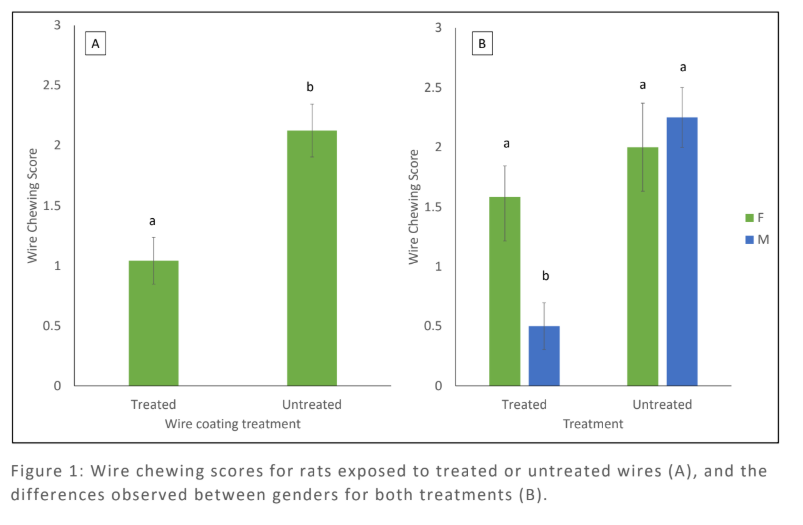ANTI-ROEDOR Compound - Scientific research
ANTI-ROEDOR Compound developed by the University of Texas - ORDER YOUR CABLE IN ANTI-ROEDOR VERSION.
Result 1: Treated cables drove the rats away.
Outcome 2: Greater efficacy was obtained in preventing chewing by male rats compared to females.
Outcome 3: Mice can learn to avoid chewing on cables over time.
Evaluation of chemically treated cable to prevent chewing by rodents
Period: April to May 2017.
Researchers: Courtney L. Daigle (PI), Peter Tutini and Logan Luskey
Animal Behavior and Welfare Laboratory, Department of Animal Science, Texas A&M
IMPORTANT POINTS:
- Treated cables kept mice away.
- Greater efficacy was obtained in preventing chewing by male rats compared to females.
- Rats may learn to avoid chewing on cables over time.
ANIMALS AND HOUSING:
Adult male (n = 12) and female (n = 12) Sprague-Dawley rats were individually housed in twenty and (24) standard laboratory cages(41 x 25 x 19 cm). All rats had access to food and water ad libidum via food funnels and water bottles attached to the outside of the cages. All rats were provided with nesting paper during periods when samples were not being tested. After testing was completed, clean nesting paper was added to each cage. The mice were exposed for a light period of 12:12: dark cycle and room temperature was maintained throughout the study at 22 °C.4
SAMPLE TESTING PROTOCOL:
A repeated square perimeter was used to assess the effectiveness of the product to prevent mice from chewing.
Mice were exposed to a single sample (approximately 2 inches in length) for 24 hours without access to nesting material. Cables were classified as "treated" or "untreated". At the end of the 24-hour test period, the samples were removed, scored (Table 1) and photographed. Mice were then given nesting material for a subsequent 24-hour period without access to any samples. At the end of the 24-hour period without sample access, all nesting material was removed, and the next treatment was placed in the cage for an additional 24 hours. This process was repeated so that each animal experienced each treatment twice in alternating order.
ANÁLISE ESTATÍSTICA:
O impacto do tratamento, gênero e repetição e suas interações nos escores de mastigação dos cabos foram avaliados com um Modelo Linear Geral (PROC GLM) no SAS v9.4. Diferenças entre os principais efeitos foram avaliados usando Mínimos Quadrados. Diferenças significativas foram identificadas em P <0,05 e tendências foram identificados em P <0,10.
RESULTS:
The interaction between gender and treatment (P = 0.02) and the main effect of treatment (P = 0.0003) influenced cable scores. Treated cables had lower copper chewing scores (e.g., were chewed less) compared to untreated cables (Figure 1a). Treated cables had the lowest chewing scores for exposed males, (Figure 1b).
Cable scores at replication 2 tended (P = 0.07) to be lower than cable scores at replication 1, suggesting that the product may have long-term efficacy beyond initial exposure. Remaining interactions and the main effect of gender (P = 0.13) did not influence cable scores (P> 0.05).
CONCLUSIONS:
The treated cables appear to deter rat chewing on the cables. The efficacy of this product is more pronounced in males, as they are less likely to chew the treated cables compared to females. There is the potential that exposure to treated cables may influence future rodent chewing behaviour.

Our specialists are able to advise you which product is best suited to your installation or project. The Engineering and Sales department has highly qualified personnel with knowledge of each market in which we operate.





